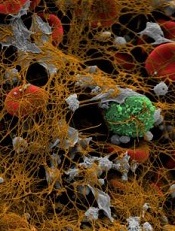
Credit: Andre E.X. Brown
Results of a large analysis indicate that adding thrombolytics to conventional anticoagulant therapy can lower the rates of death and recurrence in patients with pulmonary embolism (PE).
But the practice can also increase the risk of major bleeding and intracranial hemorrhage.
Saurav Chatterjee, MD, of St Luke’s-Roosevelt Hospital Center of the Mount Sinai Health System in New York, and his colleagues described these findings in JAMA.
The team performed a meta-analysis of 16 randomized, clinical trials of patients with PE (n=2115).
Roughly half of the patients received both thrombolytic therapy (drugs such as alteplase and tenecteplase) and conventional anticoagulation therapy (drugs such as heparin), and the other half received only conventional anticoagulation treatment.
Using criteria such as low blood pressure, heart damage revealed by diagnostic testing, and shortness of breath, physicians classified patients as being at high-risk, intermediate-risk, and low-risk of dying from PE.
Seventy-one percent of the studied patients had intermediate-risk PE, 9.9% had low-risk PE, and 1.5% had high-risk PE. Risk could not be classified in 18% of patients.
In all risk groups combined, thrombolytic therapy lowered the risk of recurrent PE when compared to anticoagulant therapy alone. The incidence of recurrent PE was 1.2% and 3%, respectively.
In addition, thrombolytic therapy was associated with a 47% decreased risk of death. There was a 2.2% incidence of mortality among patients who received thrombolytics and a 3.9% incidence among patients who received anticoagulants alone.
On the other hand, thrombolytic therapy was associated with a 2.7-times greater risk of major bleeding when compared to anticoagulants alone.
There was a 9.2% incidence of major bleeding in the thrombolytic group and a 3.4% incidence in the anticoagulant-only group. However, major bleeding was not significantly increased in patients 65 years of age and younger.
Thrombolytic therapy was also associated with a higher incidence of intracranial hemorrhage when compared to anticoagulant therapy alone, with rates of 1.5% and 0.2%, respectively.
“With this knowledge, future research can help identify subgroups of patients who are most likely to obtain [the] mortality benefit [of thrombolytic therapy] and least likely to be harmed by bleeding, particularly intracranial hemorrhage,” said study author Jay Giri, MD, MPH, of the University of Pennsylvania Perelman School of Medicine in Philadelphia.
“Research should focus on standardization of dosages of medication in thrombolysis, as well as explore the optimal method of administration—namely, intravenous vs catheter-directed therapy into the pulmonary arteries—to determine maximal clinical benefits with minimization of bleeding risk.”

